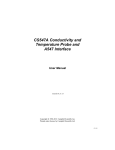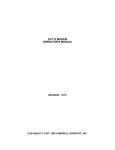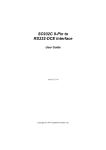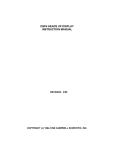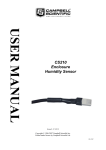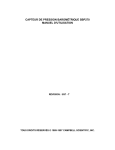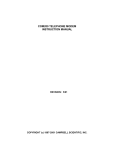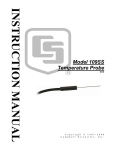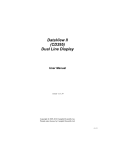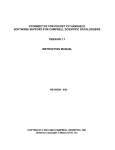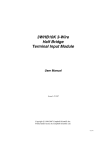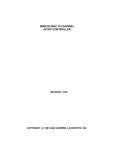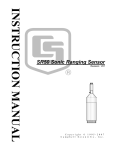Download Campbell 380 Specifications
Transcript
MET ONE RAIN GAGE MODELS 380, 385, 380M, 385M REVISION: 2/96 COPYRIGHT (c) 1993-1996 CAMPBELL SCIENTIFIC, INC. WARRANTY AND ASSISTANCE The MET ONE RAIN GAGE--MODELS 380, 385, 380M, 385M is warranted by CAMPBELL SCIENTIFIC, INC. to be free from defects in materials and workmanship under normal use and service for twelve (12) months from date of shipment unless specified otherwise. Batteries have no warranty. CAMPBELL SCIENTIFIC, INC.'s obligation under this warranty is limited to repairing or replacing (at CAMPBELL SCIENTIFIC, INC.'s option) defective products. The customer shall assume all costs of removing, reinstalling, and shipping defective products to CAMPBELL SCIENTIFIC, INC. CAMPBELL SCIENTIFIC, INC. will return such products by surface carrier prepaid. This warranty shall not apply to any CAMPBELL SCIENTIFIC, INC. products which have been subjected to modification, misuse, neglect, accidents of nature, or shipping damage. This warranty is in lieu of all other warranties, expressed or implied, including warranties of merchantability or fitness for a particular purpose. CAMPBELL SCIENTIFIC, INC. is not liable for special, indirect, incidental, or consequential damages. Products may not be returned without prior authorization. To obtain a Returned Materials Authorization (RMA), contact CAMPBELL SCIENTIFIC, INC., phone (435) 753-2342. After an applications engineer determines the nature of the problem, an RMA number will be issued. Please write this number clearly on the outside of the shipping container. CAMPBELL SCIENTIFIC's shipping address is: CAMPBELL SCIENTIFIC, INC. RMA#_____ 815 West 1800 North Logan, Utah 84321-1784 CAMPBELL SCIENTIFIC, INC. does not accept collect calls. Non-warranty products returned for repair should be accompanied by a purchase order to cover the repair. 815 W. 1800 N. Logan, UT 84321-1784 USA Phone (435) 753-2342 FAX (435) 750-9540 www.campbellsci.com Campbell Scientific Canada Corp. 11564 -149th Street Edmonton, Alberta T5M 1W7 CANADA Phone (403) 454-2505 FAX (403) 454-2655 Campbell Scientific Ltd. Campbell Park 80 Hathern Road Shepshed, Leics. LE12 9RP ENGLAND Phone (44)-50960-1141 FAX (44)-50960-1091 MET ONE RAIN GAGE MODELS 380, 385, 380M, 385M 1. INTRODUCTION Met One's tipping bucket rain or snow gage is used to measure rain or snow water equivalent on a continuous basis. The Model 380 rain gage is intended to measure rainfall during above freezing conditions. The Model 385 AC heated rain gage provides year round measurement of either rain or snow. In the standard versions Model 380/385, precipitation is measured in increments of 0.01 inches. The metric version, Model 380M/385M, available by special order, measures precipitation in increments of 0.1 mm. The Model 380 rain gage works by collecting rainfall in the 12 inch collection funnel and metering the rain into the tipping bucket assembly. When 0.01 inches of rainfall are collected, the tipping bucket assembly tips and activates a mercury switch. The switch closure is recorded by the datalogger pulse channel. When the bucket tips, the water drains out the screened base of the gage. In the case of the Model 385 heated rain gage, snowfall is captured in the collection funnel and melted by the heater element. After melting, the snow water is metered into the tipping bucket assembly for measurement of the snow water equivalent. 2. SPECIFICATIONS MODEL 380/380M RAIN GAGE Funnel: 12 inch (30.5 cm) Accuracy: ±0.5% < 0.5"(1.27 cm)/hr rate ±2.0% < 3.0"(7.62 cm)/hr rate Resolution: 380: 380M: Environmental Conditions: Temperature: 0°C to +50°C Humidity: 0 to 100% Dimensions: Weight: Height: Diameter: 7 pounds (3.2 kg) w/ 50 ft. signal cable 14" (35.5 cm) 12" (30.5 cm) MODEL 385/385M AC HEATED RAIN GAGE Specifications same as Model 380/380M unless listed below. Environmental Conditions: Temperature: -20°C to +50°C Humidity: 0 to 100% Weight: 12.2 pounds (5.57 kg) w/ 50' power/signal cable Heater Power Specification: Voltage: 115VAC (50/60Hz) Current: 5 amps maximum Heater: 300W Cartridge Element NOTE: The black outer jacket of the cable ® is Santoprene rubber. This compound was chosen for its resistance to temperature extremes, moisture, and UV degradation. However, this jacket will support combustion in air. It is rated as slow burning when tested according to U.L. 94 H.B. and will pass FMVSS302. Local fire codes may preclude its use inside buildings. 0.01 inch 0.1 mm 1 MET ONE RAIN GAGE 385-SV ( ) FIGURE 1. 385 Met One Rain and Snow Gage 3. INSTALLATION 3.1 LOCATION The rain or snow gage should be mounted in a relatively level spot which is representative of the surrounding area. The lip of the funnel should be horizontal and at least 30 inches above the ground. Install the snow gage high enough to prevent burial by snow during the winter months. The ground surface around the rain gage should be natural vegetation or gravel. The gage should not be installed over a paved or concrete surface. The rain or snow gage should be placed away from objects that obstruct wind. The minimum distance should be 2 times the height of the obstruction or more. 3.2 MOUNTING The rain or snow gage is designed to mount on a flat surface. Three equally spaced adjustable mounting legs are provided. The mounting legs are pre-drilled for 1/4" bolts on a 9.66" diameter bolt circle. A mounting bracket is available from Campbell Scientific (P/N 7792) to install either the rain or snow gage on a 1-1/4" threaded pipe. The mounting bracket provides additional adjustment for leveling the rain or snow gage. A typical snow gage installation is illustrated in Figure 2. 2 Loosen the three screws and lift the housing assembly from the base. Adjust the three slotted feet on the base of the rain gage and/or the three nuts on the 380MB to level the gage. A bubble level is mounted on the base to facilitate leveling. Remove the rubber shipping band securing the stainless steel tipping bucket assembly. Verify the bucket tips freely and that all the adjusting screws are tight. Replace the housing assembly and tighten the three screws to secure the housing to the base. 3.3 WIRING WARNING: Disconnect heater power before attempting to service or repair this equipment. Failure to do so may result in personal injury or death due to electrocution. 3.3.1 DATALOGGER WIRING CR10, 21X, and CR7: BLACK(+5V)-------------------Pulse Channel CLEAR(Ground)--------------GND WHITE(Shield)----------------GND MET ONE RAIN GAGE The BLACK (+5V Signal) lead connects to a pulse channel. The CLEAR (Power Ground) connects to any ground channel (G). The WHITE (shield) lead connects to any ground channel (G). The purpose of the shield wire is to drain any charges built up in the cable due to transients etc. NOTE: If a pulse channel is not available, Control Port 7 or 8 can be used to record switch closures from a rain gage with the CR10 datalogger. Refer to the CR10 datalogger manual, section 8.5, for additional information. 3.3.2 HEATER WIRING Attach the power plug supplied with the Model 385 by following the instructions supplied with the plug. The electric heated snow gage requires 115VAC (50/60hz), 5 amps maximum, to operate the heater. If supplying your own signal or power cable, refer to Figure 3 for an illustration of cable installation. The heater should be unplugged during warmer months to prevent evaporation during low rainfall and to minimize wear and tear on the heater element. NOTE: The heater thermostat is factory set and requires no field adjustment. BDR320: BLACK (+5V)-------------------------P1 CLEAR (Ground)--------------------GND WHITE (Shield)----------------------GND NOTE: On BDR320's, only pulse channel 1 can be used to measure a tipping bucket signal. 3 MET ONE RAIN GAGE FIGURE 2. Typical Snow Gage Installation 4 MET ONE RAIN GAGE P/N 2196 (2) Plcs. 6" Cut Shield Off Flush to Jacket 8" 3/8" 3/8" CLEAR CLEAR SHIELD BLACK BLACK White Heat Shrink Heat Shrink (2) Plcs. P/N 2222 Beldon #8641 P/N 2196 (3) Plcs. 2" 3/8" 8" 3/8" BLACK WHITE GREEN Heat Shrink (2) Plcs. P/N 7805 Beldon #1934B FIGURE 3. Typical Cable Construction and Connection 5 MET ONE RAIN GAGE 3.4 DATALOGGER INSTRUCTIONS CR10, 21X, CR7 Programming: The Model 380 rain gage is measured using Instruction 3 configured for a switch closure (option code 2). In the following example, the CR10 continuously measures rainfall and outputs the time, date, and total rainfall every 60 minutes: Input Location Labels: 01: 01: 01: 02: 03: 04: 05: 06: 1 60 P3 1 1 2 1 0.01 0 5. CALIBRATION The sensor is factory calibrated; recalibration is not required unless damage has occurred or the adjustment screws have loosened. Nevertheless, the following calibration check is recommended once every 12 months: a. Remove the housing assembly from the base by loosening the three screws and lifting upward on the housing. 1. Rain (in) * assembly. Verify the tipping bucket assembly moves freely, and that the datalogger records 0.01 in or 0.1 mm for each bucket tip. Table Programs Sec. Execution Interval Pulse Rep Pulse Input Channel Switch Closure Loc [:Rain (in)] Mult Offset 02: 01: 02: 03: P92 0 60 10 If time is minutes into a minute interval Set high Flag 0 03: 01: P77 110 Real Time Day,Hour-Minute 04: 01: 02: P72 1 1 Totalize Repetitions Starting Input Location 05: P End Table 1 b. Check bubble level to verify sensor is level. c. Pour water through the inner funnel to wet the two bucket surfaces. Using a graduated cylinder, slowly pour the appropriate amount of water (refer to Table 1) through the inner funnel to the tipping bucket, which should tip once. Repeat for the other bucket. If both buckets tip when filled with the appropriate amount of water (refer to Table 1), the sensor is properly calibrated and no additional adjustment is needed. If either bucket fails to tip, recalibrate as follows: 1. Release the lock nuts on the cup adjustments. 2. Move the adjustment screws down to a position that would place the bucket far out of calibration. 3. Pour the appropriate amount of water (see Table 1) into the inner funnel (i.e. 18.52 ml for 0.01 inches of rain / tip): In all dataloggers, a multiplier of 0.01 converts the output to inches and a multiplier of 0.254 converts the output to millimeters. Conversion Factors: Tip to in3: 113.04 in2 (catch orifice area) x increment in inches. The metric versions use a multiplier of 0.1 to convert output to millimeters. A multiplier of 0.00394 converts the output to inches. in3 to ml: multiply by 16.3881. 4. MAINTENANCE During each site visit, check for and remove any debris, insects, sediment, etc. from the collection funnel, debris screens, or tipping bucket 6 ml to ounces: multiply by 0.03382. 4. Turn the cup adjustment screw, opposite the full bucket, up until the bucket assembly tips. Tighten the lock nut. MET ONE RAIN GAGE 5. Repeat steps 3 and 4 for the opposite bucket. 5.1 FACTORY RECALIBRATION: Factory recalibration is available from either Campbell Scientific Incorporated or Met One Instruments. Please call and request an RMA number prior to returning any equipment to Campbell Scientific Incorporated 6. Repeat steps 1-5 to ensure proper calibration. 7. Reinstall the housing assembly and tighten the three screws. TABLE 1 Tip Increment in3 ml ounces 0.01 in 1.130 18.52 0.63 0.1 mm 0.445 7.29 0.25 0.2 mm 0.890 14.59 0.49 0.25 mm 1.113 18.23 0.62 7









